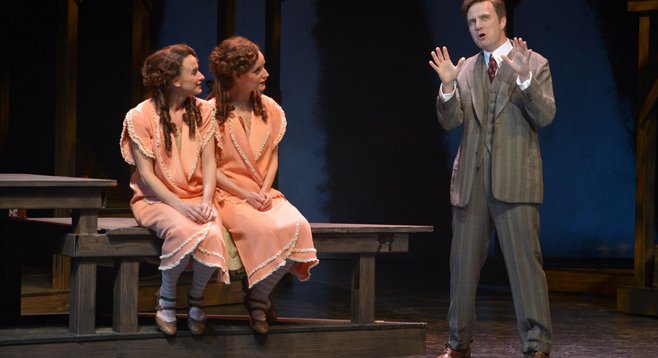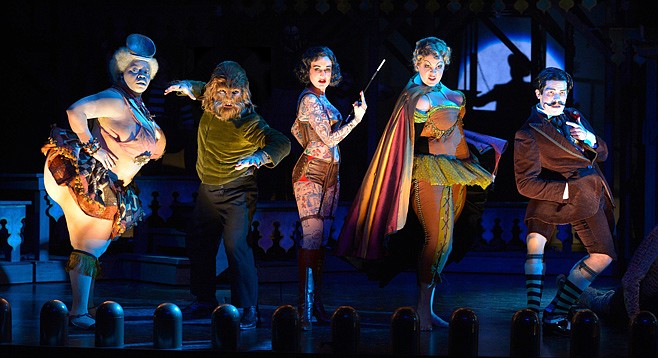 Facebook
Facebook
 X
X
 Instagram
Instagram
 TikTok
TikTok
 Youtube
Youtube

They say that composer Henry Krieger and librettist/lyricist Bill Russell’s 1997 musical has a cult following. If so, the cult deserves better than their “re-imagined” version at the Playhouse.
Make that de-imagined.
Daisy and Violet Hilton were twins conjoined at the hip. They became a vaudeville sensation in the 1920s and, by the early 30s, were as famous as Harry Houdini. They, and their exploited career, are featured in the 1932 film Freaks and in Leslie Zemeckis’s excellent 2012 documentary Bound by the Flesh.
If you’ve seen either, you’ll wonder why Side Show gets so little of their compelling story, and can’t settle on what it’s about.
Other, that is, than sell tickets. Stock characters speak – and often sing – stock dialogue and lyrics. The story, like a rambling Wikipedia précis, is achingly predictable. There is no subtlety or shading. All choices favor a glossy commercial appeal that glosses over sharp edges.
You can even predict that when someone says “freaks” on a movie soundstage, the floodlights will flash first on the audience.
The sisters became experts at marketing themselves. They ruled the tabloids much more, say, than today’s Paris Hilton. They either conceived, or got talked into, false marriages and other PR stunts. They were exploited and self-exploiting. As the Zemeckis film points out, they were also naïve and brutally abused by their manager.
The re-imagined book’s a structural mess. Act one uses 16 songs and almost 90 minutes merely to set the stage for Act two. The only bridge during intermission is The Question: what if Daisy or Violet falls in love? How will she – i.e. they – have sex?

Act two parodies The Question with the funny, “1+1= 3,” but doesn’t answer it (though Houdini’s suggestion about finding a private mental cubbyhole looked like the set-up for a solution, of sorts).
When the cows come home in Act two, the book hustles them back out to pasture. The last half hour, in particular, is crammed with revelations enough for two musicals. But squelches reactions.
Viola tells faithful and true Jake, the sisters’ African-American bodyguard, she can’t marry him because it would cause her social discomfort. Wait! Whoa! Huh? Before David St. Louis’s Jake can respond to the jilt – and its implicit racism – the scene shifts and leaves him hanging.
The manager’s lover committed suicide? Rather than own up, the scene shifts – to Hollywood!
This demons-be-damned approach touches on, but refuses to address, extremes. The book wants to pit “normal” – whatever that means – against difference. And no complications, please.
Except for every song having, it seems, the same lead in, it’s easy to see why Krieger’s score has such appeal. The composer of Dreamgirls includes vaudeville pizzazz (“Come Look at the Freaks”), Jake’s no-place-like home cautionary tune (“The Devil You Know”), and moving duets for the sisters (“Who Will Love Me As I Am?”; “I Will Never Leave You”).
Paul Tazwell’s costumes (and the “freaks’" terrific make-up and wigs) cast all focus on the twins, usually wearing white, though the set’s drab, movable units overstate the contrast.
It was great to see Robert Joy back at the Mandell Weiss (he played Mercutio in the “new” Playhouse’s inaugural season in ‘83, which makes him an LJP “founding actor”). But Joy’s stuck in a half-note role as the sisters’ evil entrepreneur and pushes too hard.
As the Hilton sisters, Emily Padgett and Erin Davie sing and dance beautifully (especially Anthony Van Laast’s hilarious “tennis anyone?” choreography).
Now if the book would give them a subtext or two to play, and something more than extrovert/introvert personal differences, they’d excel at that too.


They say that composer Henry Krieger and librettist/lyricist Bill Russell’s 1997 musical has a cult following. If so, the cult deserves better than their “re-imagined” version at the Playhouse.
Make that de-imagined.
Daisy and Violet Hilton were twins conjoined at the hip. They became a vaudeville sensation in the 1920s and, by the early 30s, were as famous as Harry Houdini. They, and their exploited career, are featured in the 1932 film Freaks and in Leslie Zemeckis’s excellent 2012 documentary Bound by the Flesh.
If you’ve seen either, you’ll wonder why Side Show gets so little of their compelling story, and can’t settle on what it’s about.
Other, that is, than sell tickets. Stock characters speak – and often sing – stock dialogue and lyrics. The story, like a rambling Wikipedia précis, is achingly predictable. There is no subtlety or shading. All choices favor a glossy commercial appeal that glosses over sharp edges.
You can even predict that when someone says “freaks” on a movie soundstage, the floodlights will flash first on the audience.
The sisters became experts at marketing themselves. They ruled the tabloids much more, say, than today’s Paris Hilton. They either conceived, or got talked into, false marriages and other PR stunts. They were exploited and self-exploiting. As the Zemeckis film points out, they were also naïve and brutally abused by their manager.
The re-imagined book’s a structural mess. Act one uses 16 songs and almost 90 minutes merely to set the stage for Act two. The only bridge during intermission is The Question: what if Daisy or Violet falls in love? How will she – i.e. they – have sex?

Act two parodies The Question with the funny, “1+1= 3,” but doesn’t answer it (though Houdini’s suggestion about finding a private mental cubbyhole looked like the set-up for a solution, of sorts).
When the cows come home in Act two, the book hustles them back out to pasture. The last half hour, in particular, is crammed with revelations enough for two musicals. But squelches reactions.
Viola tells faithful and true Jake, the sisters’ African-American bodyguard, she can’t marry him because it would cause her social discomfort. Wait! Whoa! Huh? Before David St. Louis’s Jake can respond to the jilt – and its implicit racism – the scene shifts and leaves him hanging.
The manager’s lover committed suicide? Rather than own up, the scene shifts – to Hollywood!
This demons-be-damned approach touches on, but refuses to address, extremes. The book wants to pit “normal” – whatever that means – against difference. And no complications, please.
Except for every song having, it seems, the same lead in, it’s easy to see why Krieger’s score has such appeal. The composer of Dreamgirls includes vaudeville pizzazz (“Come Look at the Freaks”), Jake’s no-place-like home cautionary tune (“The Devil You Know”), and moving duets for the sisters (“Who Will Love Me As I Am?”; “I Will Never Leave You”).
Paul Tazwell’s costumes (and the “freaks’" terrific make-up and wigs) cast all focus on the twins, usually wearing white, though the set’s drab, movable units overstate the contrast.
It was great to see Robert Joy back at the Mandell Weiss (he played Mercutio in the “new” Playhouse’s inaugural season in ‘83, which makes him an LJP “founding actor”). But Joy’s stuck in a half-note role as the sisters’ evil entrepreneur and pushes too hard.
As the Hilton sisters, Emily Padgett and Erin Davie sing and dance beautifully (especially Anthony Van Laast’s hilarious “tennis anyone?” choreography).
Now if the book would give them a subtext or two to play, and something more than extrovert/introvert personal differences, they’d excel at that too.
Comments